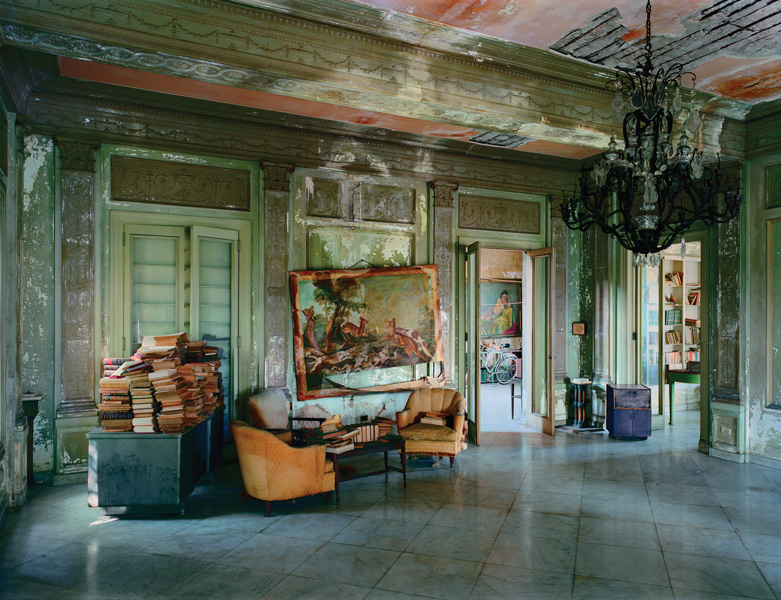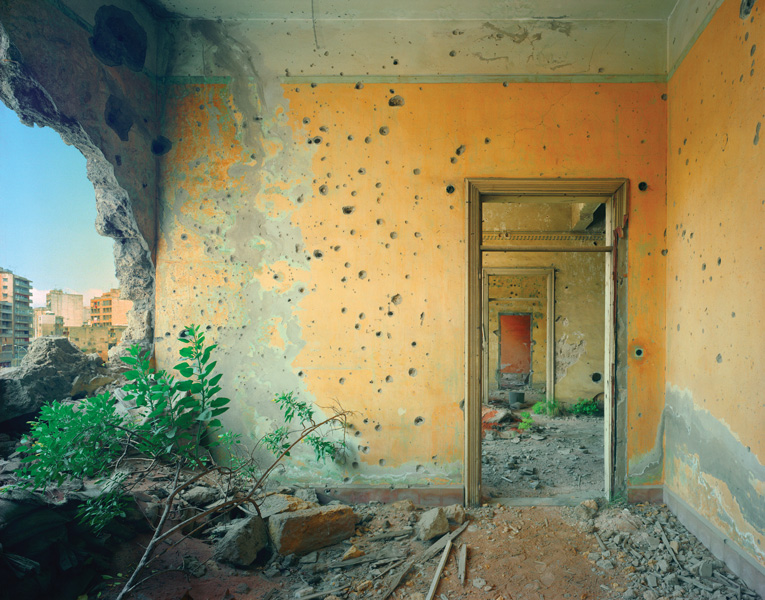[Fall 2009]
John K. Grande: The theme of the power of nature enters into your work, as with the photographs of the flood in New Orleans. There is something ironic about that – the way you have all this built civilization with the nature entering into it.
Robert Polidori: If what you are fish- ing for what is Canadian about my work, I would say it is a kind of conscious approach to objectivity, and also trying not to editorialize. I like to have multiple simultaneous truths.
JG: More than a single truth, in other words.
RP: Yes; I have become a real polytheist. Twenty percent of the image is going in one direction as if editorializing in one way, but then another part of the image is going in another direction, editorializing in another way; it is not through distance but through layering.
JG: Your approach to composition is influenced by your experience working in film with the Anthology Film Archives in the 1970s. Can you tell me about your early projects there?
RP: I went to New York and was attending university – my freshman year – and I was in Tampa, Florida. Annette Michelson came as a visiting professor. She gave a lecture in Tampa where she showed the film Wavelength by Michael Snow. That was a very influential experience. I quit college after that. I didn’t flip out over it and there was no sense of overbearing nationalism or anything like that. I didn’t really know that Michael was Canadian. So that, for me, was a seminal shock. As you know, Wavelength is really a film about temporality; Michael Snow has called it “a monument to time.” It was a certain way of looking at, but also of feeling about, time. I made films in the late 1960s and early 1970s. What were they like? I would call them like lyrical poems. If anything, they were closer to Jonas Mekas’s films. Some were shorts, and some were 45 minutes long. I didn’t think about length.
JG: And what made you turn to photography from film?
RP: When I turned to photography it was really because of this book called The Art of Memory by Frances Yates.
JG: About ancient mnemonic systems.
RP: Yes, Greek and Roman mnemonic systems.
JG: Yates describes how the ancient Greek rhetorician Cicero explains the process to his students in Ad Herennium (86–82 BCE): “In order to form a series of places in memory, he [Cicero] says, a building is to be remembered, as spacious and varied a one as possible, the forecourt, the living room, bedrooms, and parlours, not omitting statues and other ornaments with which the rooms are decorated. The images by which the speech is to be remembered … are then placed in imagination on the places which have been memorized in the building. This done, as soon as the memory of the facts requires to be revived, all these places are visited in turn and the various deposits demanded of their custodians. We have to think of the ancient orator as moving in imagination through his memory building whilst he is making his speech, drawing from the memorized places the images he has placed on them. The method ensures that the points are remembered in the right order, since the order is fixed by the sequence of places in the building. Quintilian’s examples of the anchor and the weapon as images may suggest that he had in mind a speech which dealt at one point with naval matters (the anchor), at another with military operations (the weapon).”1 One thinks of the art of memory when looking at the corridors in the Versailles photographs that you took.
RP: The students of the art of memory used to have to memorize these empty rooms. At the Pythagorean School in Crotone, Calabria, the students were not allowed to speak for the first two years and had to memorize rooms. It came more from that side. I left film because it was too expensive. I really look at film now as being a social privilege. I think that anyone who is even middle class has a digital camera. Even in India now people have cameras; it has become almost a birthright. I was influenced by that book and looking at rooms becoming metaphors of memory.
JG: And when we look at these rooms and houses in your book New Orleans After the Flood, we are looking into people’s very per- sonal lives, a personal world turned upside down, the ravages of time. I think of Byron and Shelley – the Romantics – who looked at ruins as metaphors for past civilizations, traces of lives long ago vanished. There is this thing about God, the hand of God in your work. And then there is the aspect of time. Your New Orleans and Lebanon photographs present an aspect of this metaphor for time that can be romantic or, alternatively, tragic. What is ordinary one day can be something else the next … and what remains? When we are looking at the photographs of New Orleans, these rooms are not the cadavers of people’s bodies; these are the exoskeletons of an interrupted life. So, the way that snakes shed their skins, these are exoskeletons that have been shed.
RP: When we are looking at the photographs of New Orleans, these rooms are not the cadavers of people’s bodies; these are the exoskeletons of an interrupted life. I would think that the majority of the inhabitants of these rooms are living someplace else. They are still living today. They have another life now. So, the way that snakes shed their skins, these are exoskeletons that have been shed. These are all the clues you have left to their prior trajectories.
JG: I do believe that your photographs have the aspect of social commentary and the idea that the photographer can influence society, even through media. When I look at one of your Havana photographs, the one of the Countess’s former house, and the walls now repaired – indeed, covered with all those tiny boards. It is truly a comment on colonialism and indigenous culture, a powerful statement.
RP: The thing is that people often will call me an architectural photographer. I hate that. I do photograph interiors and buildings, so I am not saying they are completely out of line. What I am saying is that architectural photography is basically about making a product shot for an architect or a developer. I say that I am a habitat photographer. I photograph the way a society uses and even alters a space. That is what I am into. I won’t lie to you: I have had to do photographs of buildings for a client for my livelihood, but I don’t care about that.
JG: You have said that there is no fiction stranger than reality. I think you have hit the nail on the head there, especially after seeing the photographs on view at the Musee d’art contemporain de Montréal. They bear witness to transformations in many places around the world. Do you believe that photography can play a role in influencing society in a world in which there are so many visual cues, in which so many visuals are being fed to us all the time?
RP: That is an ongoing question. This came up two months ago. I am friends with Jeff Rosenheim, who is the photography curator at the Metropolitan Museum. I love the work of Sebastião Salgado, except that I do not like anything in black and white and I don’t like anything shot in 35 mm. I don’t like the technical quality of it. To me it is not precise enough, but I sort of pardon it with him, because he knows what to shoot and what to look at. He said he couldn’t disagree more. What Rosenheim did not like about his photography was the notion that photography can save the world. I never thought about it like that. I think that to believe that a photograph can change the world is asking a lot, but I think that you can contribute to change.
JG: Your works are very hands-on and close-up, not industrial at all in scale, and very human. They reveal the human details.
RP: I think that is because I live in New York. It is hard to escape it. Probably it is because people don’t live in proximity to one another in Canada, they have greater distance. The places I choose to live in are highly urban. It is a balance that has to be achieved. If you are too close, and are suddenly too influenced by your subject, you lose your objectivity, which means the work lacks a certain truth.
JG: Do you set up your photos, or is there an element of accident to the way you enter into the scenes you photograph?
RP: What do you mean by “set up”? I use tripods and so on.
JG: How do you set up the image in your mind? Is it a matter of walking around, getting to know a place, following your instinct?
RP: In New Orleans, it was everywhere. I just found the spaces and photographed them. On the other hand, it was my driver who pointed out the image of Madame Faxas’s house that was on the cover of my Havana book. He was a smart guy. Cubans are clever. He said, “Oh, you like this kind of stuff. You have to see the Casa de la Loca.” Then he took me there. I am not saying others don’t help me. Everything is a process. Basically I find all my own material. I just have the nose for finding it.
John K. Grande’s Dialogues in Diversity: Art from Marginal to Mainstream was published by Pari Publishing (Italy) in 2007 (www. paripublishing.com). Art Allsorts: Writings on Art & Artists, Vols. 1 and 2 (2008, 2009) are now available ( www.lulu.com). Stonehenge & Avebury, a collaboration with the artist Arnold Shives, recently won an Alcuin Society prize. John Grande is curator of Earth Art 2009 at the Royal Botanical Gardens, Hamilton (www.rbg.ca ). www.grandescritique.com


